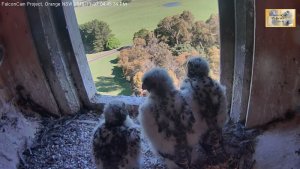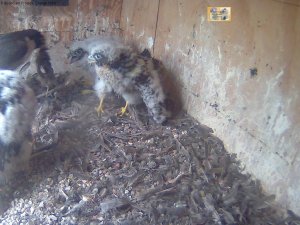Telling juvenile birds apart at this age has always been a bit tricky because, although females are eventually much larger than males, there is little to split them now because the males actually develop faster than the females.
And you need to remember that the three birds are all slightly different ages, compounding the complexity.
Once the bird’s wing length is > 9 cm, however, one can determine sex with reasonable certainty, which is useful as it is now when the birds are usually banded (about 4 weeks). So, according to Victor Hurley et al’s paper in 2007, there should now be significant differences between the female and male in relation to tarsus length, head-bill length, tip-cere lenth and body mass. Unfortunately, one needs to have the bird in the hand to get these measurements…
Having said that, and based on estimate of body mass, I think Clare is right when she says there are two females and one male. Certainly there is one bird quite a bit smaller and he is well into juvenile plumage, so not ‘immature’ or younger.

I’ve noticed that usually only bird feeds at a time and there is little aggression between the chicks, apart from the occasional (and increasing) tugs of war, and sleight of hand nicking when the other is distracted, and they do all still seem to be getting enough to eat. There are young starlings a plenty, plus the odd racing pigeon coming in…and well appreciated by the young chicks.

I’ll be away from tomorrow until Thursday, but have sent an alert around to staff at what to do if they find a chick out of the nest. They certainly shouldn’t be attempting anything till about 18th November, but the best laid plans and all that.
Wow – brilliant three-way tug of war just now! That’s the most aggressive I’ve seen so far.
Good to say that our smallest bird is staring to fight for his food. Life is tough out there for a young peregrine
Cilla (at my conference)
I got a fab screenshot today of a meal delivery to some screaming chicks. To whom do I send it to share it on the site?
A few heart in the mouth moments this morning between 6.20 and 6.45. A few wing flaps on the ledge and a few where I thought the clumsy one was going to knock the little one out. The more adventurous of the two big chicks backed up onto the ledge and almost fell out!! At 6.45 you can see both parents flying past. I thought it might be enough to have the little one soar out as they were on the ledge, but instead it went back into the nest.
Dee, I saw that and had the same reaction! Little Tardy is very adventurous, isn’t he? I wish he’d stop playing on the ledge! It seems to be his favourite spot.
Hi Scott and Cilla. Scott, you mentioned that the subspecies for these Peregrines is “macropus”. In North America our subspecies is “anatum” (duck hawk). Aside from geography, are there any differences in the two?
Just to say that there is no need to send photos to me unless you wish to. I go through the recordings 24/7, so I rarely miss things (but the best laid plans of mice and men, it does happen occasionally). If there’s a particular shot you want me to load, send it to me at ckinross{at}csu.edu.au (need to substitute the @ in place of the {at} and I can load it for you.
It’s probably going to take me a week to catch up now, and I obviously prefer to do updates, when I’ve caught up, otherwise it’s old news for you guys, although I’ll try on Saturday (I have a landcare event on Sunday). And fledging should start next week. I’ll be around all week, in and out.
Macro = big and pus = feet, so our Australian peregrines have large feet. there are also minor plumage and size differences as well, but not so you would notice as these vary within a subspecies as well.
thanks for all your input.